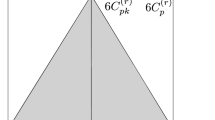Abstract
Identification of the product platform is a key step in designing a family of products. This article presents a methodology for selecting the product platform by using information obtained from the individual optimization of the product variants. Under the assumption that the product variety requires only mild design changes, a performance deviation vector is derived by taking into consideration individual optimal designs and sensitivities of functional requirements. Commonality decisions are based on values of the performance deviation vector, and the product family is designed optimally with respect to the chosen platform. The proposed methodology is applied to the design of a family of automotive body structures. Variants are defined by changing the functional requirements they need to satisfy and/or the geometry of the associated finite element models.
Similar content being viewed by others
References
Conner, C.G.; De Kroon, J.P.; Mistree, F. 1999: A product variety tradeoff evaluation method for a family of cordless drill transmissions. In: Proceedings of the 1999 ASME Design Engineering Technical Conferences (held in Las Vegas), Paper No. DAC-8625
Ericsson, A.; Erixon, G. 1999: Controlling design variants: modular product platforms. Dearborn: Society of Manufacturing Engineers
Fellini, R.; Kokkolaras, M.; Papalambros, P.; Perez-Duarte, A. 2002: Platform selection under performance loss constraints in optimal design of product families. In: Proceedings of the 2002 ASME Design Engineering Technical Conferences (held in Montreal), Paper No. DAC-34099; also submitted to J. Mech. Des.
Fellini, R.; Papalambros, P.; Weber, T. 2000: Application of a product platform design process to automotive powertrains. In: Proceedings of the 8th AIAA/NASA/USAF/ISSMO Symposium on Multidisciplinary Analysis and Optimization (held in Long Beach), Paper No. AIAA-2000-4849
Fenyes, P.A. 2000: Multidisciplinary design and optimization of automotive structures – a parametric approach. In: Proceedings of the 8th AIAA/NASA/USAF/ISSMO Symposium on Multidisciplinary Analysis and Optimization (held in Long Beach), Paper No. AIAA-2000-4706
Fujita, K.; Yoshida, H. 2001: Product variety optimization: simultaneous optimization of module combination and module attributes. In: Proceedings of the 2001 ASME Design Engineering Technical Conferences (held in Pittsburg), Paper No. DAC-21058; also to appear in Concurrent Eng.: Res. Appl.
Gonzalez-Zugasti, J.P.; Otto, K.N. 2000: Modular platform-based product family design. In: Proceedings of the 2000 ASME Design Engineering Technical Conferences (held in Baltimore), Paper No. DAC-14238
Gonzalez-Zugasti, J.P.; Otto, K.N.; Baker, J.D. 1998: A method for architecting product platforms with an application to interplanetary mission design. In: Proceedings of the 1998 ASME Design Engineering Technical Conferences (held in Atlanta), Paper No. DAC-5608; also appeared in 2000, Res. Eng. Des. 12(1), 48–60
Kokkolaras, M.; Fellini, R.; Kim, H.M.; Michelena, N.F.; Papalambros, P.Y. 2002: Extension of the target cascading formulation to the design of product families. Struct. Multidisc. Optim. 24(4), 293–301
Messac, A.; Martinez, M.P.; Simpson, T.W. 2000: Effective product family design using physical programming and the product platform concept exploration method. In: Proceedings of the 2000 ASME Design Engineering Technical Conferences (held in Baltimore), Paper No. DAC-14252; also appeared in 2002, Eng. Optim. 34(3), 245–261
Meyer, M.H.; Lehnerd, A.P. 1997: The power of product platforms. New York: The Free Press
Nayak, R.U.; Chen, W.; Simpson, T.W. 2000: A variation-based methodology for product family design. In: Proceedings of the 2000 ASME Design Engineering Technical Conferences (held in Baltimore), Paper No. DAC-14264; also appeared in 2002, Eng. Optim. 34(1), 65–81
Nelson, S.A.; Parkinson, M.B.; Papalambros, P.Y. 1999: Multicriteria optimization in product platform design. In: Proceedings of the 1999 ASME Design Engineering Technical Conferences (held in Las Vegas), Paper No. DAC-8676; also appeared in 2001, J. Mech. Des. 123(2), 199–204
Siddique, Z.; Rosen, D.W.; Wang, N. 1998: On the applicability of product variety design concepts to automotive platform commonality. In: ASME Design Engineering Technical Conferences (held in Atlanta), Paper No. DTM-5661
Simpson, T.W.; Maier, J.R.A.; Mistree, F. 1999: A product platform concept exploration method for product family design. In: Proceedings of the 1999 ASME Design Engineering Technical Conferences (held in Las Vegas), Paper No. DTM-8761; also appeared in 2001, Product platform design: method and application. Res. Eng. Des. 13(1), 2–22
Zillober, C. 2001: Software manual for SCPIP 2.2. Technical Report Nr. TR01-2, Informatik, Universitaet Bayreuth
Author information
Authors and Affiliations
Corresponding author
Rights and permissions
About this article
Cite this article
Fellini , R., Kokkolaras , M., Michelena , N. et al. A sensitivity-based commonality strategy for family products of mild variation, with application to automotive body structures. Struct Multidisc Optim 27, 89–96 (2004). https://doi.org/10.1007/s00158-003-0356-x
Received:
Published:
Issue Date:
DOI: https://doi.org/10.1007/s00158-003-0356-x




